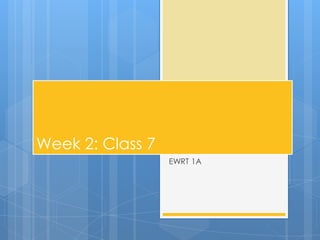
Fall 1 a 7
- 1. Week 2: Class 7 EWRT 1A
- 2. AGENDA Presentation: Vocabulary Lecture: Formatting dialogue In-Class Writing: Practicing Dialogue
- 3. The Game • Create alliances of five or six people • Discuss the words on the next slide for five or so minutes and prepare to compete • Each team will send one member to the board in rotation. • I will read a definition • The first team member to write the correct definition on the board scores a point for their team. • Teams earn participation points for each correct answer • The team with the highest score at the end of the game earns not only the glory of winning but also five additional participation points.
- 4. Vocabulary
- 5. Writing Dialogue A Writing Strategy for the Narrative Essay
- 6. Writing dialogue Dialogue is an important part of any remembered event. It shows what happens instead of telling it. For example, you can say “she was so mad she yelled at me.” Or you can show the dialogue and let the reader “see” her mad at you. “You did what? You threw out my best shirt?!” “I am sorry, but I didn’t think you wanted that shirt any more. It was torn and stained” “What kind of ass are you? Was that your shirt? No, it was mine!” “But…..ummm” “DON’T TOUCH MY STUFF! IN FACT, GET OUT!”
- 7. DIALOGUE MOVES THE STORY But we don’t just add dialogue just to say we have it. Dialogue should move the plot, too. For example, if we are out to dinner, we don’t write a page of dialogue about how we decided what to eat. It is just too boring! “What are you going to have?” “I dunno; how about you?” “Oh, I can’t decide between the chicken and the fish” “Me neither” See my point? No one cares about this kind of dialogue!
- 8. Formatting Dialogue Each speaker gets his or her own paragraph: a return and indent. This mimics real conversation, indicating pauses and so forth. Attributions (“He said,” “She said” and variations) should be used, but not too much, and varied so they’re not repetitious; they can be used at the start of quotations, in the middle, or at the end. When attributions are overused, they get in the way; the key is that the reader should always know who’s speaking. Always use a comma after attribution (She said,) when introducing a quote. Example: “What’s wrong with you?” he asked. “Nothing,” I said. “You lit my shirts on fire? Where’d you learn that? “Daycare.” “What? Daycare? You learned how to light shirts on fire at daycare?” “A kid brought matches one day.” “I’m calling your daycare.” “No,” I said. Okay, I screamed it, and he scowled at me. “Tell me the truth, boy.” I took a deep breath and let it slide out: “I hate your shirts, Dad.”
- 9. Exercise #1 Write a scene in which one person tells another person a story. Make sure that you write it as a dialogue and not just a first person narrative; have one person telling the story and the other person listening and asking questions or making comments. 1. A robbery you witnessed at 7-11 2. An car accident you just had 3. A car accident you almost had 4. Catching a person trying to pick-pocket you 5. Another event you want to write about
- 10. Exercise #2 Write a short conversation between multiple people in which no character speaks more than three or four words per line of dialogue. You can use minimal narration to enhance the scene, not explain the dialogue. A person is walking down a deserted street after the bar closes. He moves quickly but unsteadily. Suddenly, three teenagers come out of an alley. They grab him and drag back into the alley. Write the dialogue.
- 11. HOMEWORK Read: HG through chapter 6. As you read, look for a passage that reminds you of a personal experience you had. Post #7: the dialogues from the in-class writing Study: Vocab (Chapters 1-6). Bring: HG and SMG